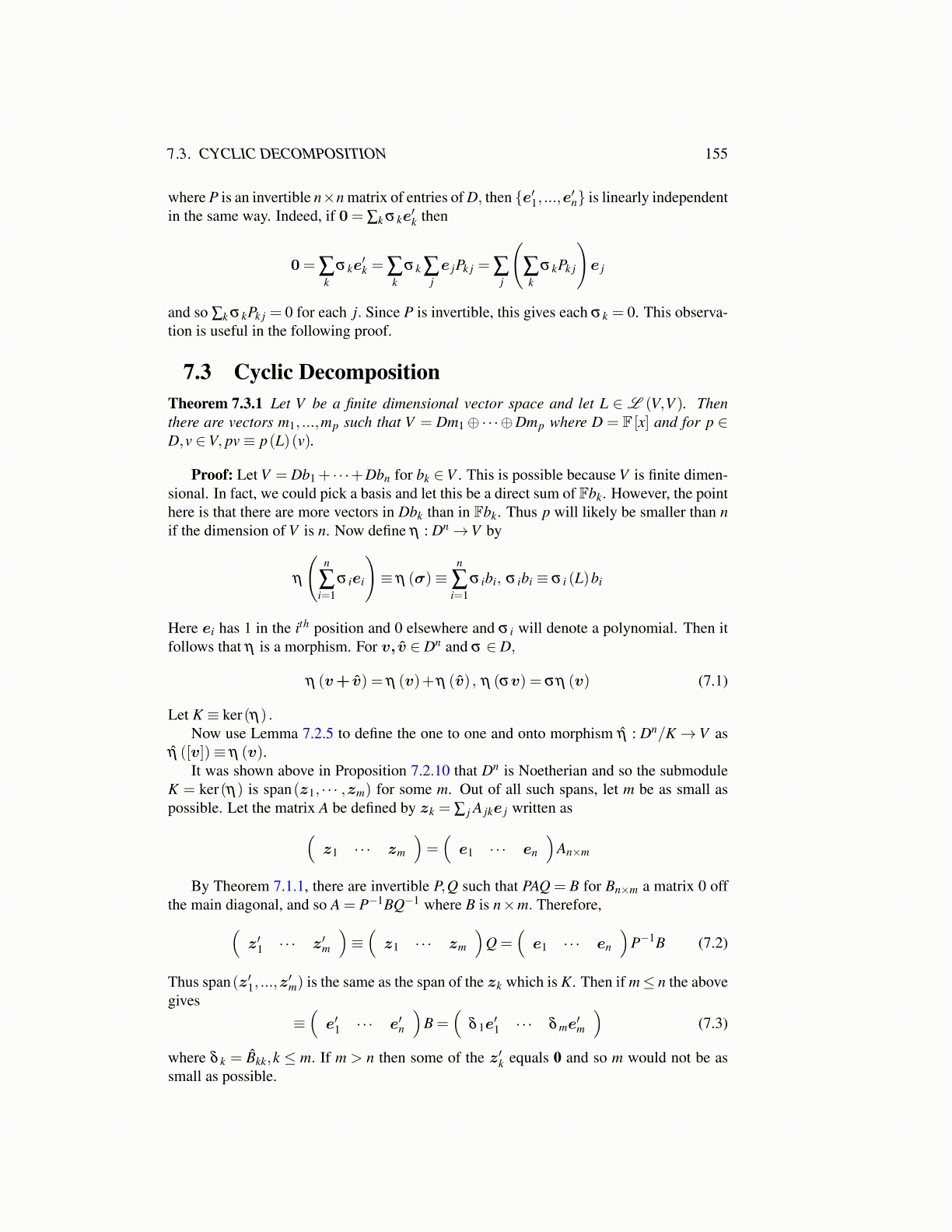
7.3. CYCLIC DECOMPOSITION 155
where P is an invertible n×n matrix of entries of D, then {e′1, ...,e′n} is linearly independentin the same way. Indeed, if 0= ∑k σ ke
′k then
0= ∑k
σ ke′k = ∑
kσ k ∑
je jPk j = ∑
j
(∑k
σ kPk j
)e j
and so ∑k σ kPk j = 0 for each j. Since P is invertible, this gives each σ k = 0. This observa-tion is useful in the following proof.
7.3 Cyclic DecompositionTheorem 7.3.1 Let V be a finite dimensional vector space and let L ∈ L (V,V ). Thenthere are vectors m1, ...,mp such that V = Dm1⊕·· ·⊕Dmp where D = F [x] and for p ∈D,v ∈V, pv≡ p(L)(v).
Proof: Let V = Db1 + · · ·+Dbn for bk ∈V . This is possible because V is finite dimen-sional. In fact, we could pick a basis and let this be a direct sum of Fbk. However, the pointhere is that there are more vectors in Dbk than in Fbk. Thus p will likely be smaller than nif the dimension of V is n. Now define η : Dn→V by
η
(n
∑i=1
σ iei
)≡ η (σ)≡
n
∑i=1
σ ibi, σ ibi ≡ σ i (L)bi
Here ei has 1 in the ith position and 0 elsewhere and σ i will denote a polynomial. Then itfollows that η is a morphism. For v, v̂ ∈ Dn and σ ∈ D,
η (v+ v̂) = η (v)+η (v̂) , η (σv) = ση (v) (7.1)
Let K ≡ ker(η) .Now use Lemma 7.2.5 to define the one to one and onto morphism η̂ : Dn/K → V as
η̂ ([v])≡ η (v).It was shown above in Proposition 7.2.10 that Dn is Noetherian and so the submodule
K = ker(η) is span(z1, · · · ,zm) for some m. Out of all such spans, let m be as small aspossible. Let the matrix A be defined by zk = ∑ j A jke j written as(
z1 · · · zm
)=(
e1 · · · en
)An×m
By Theorem 7.1.1, there are invertible P,Q such that PAQ = B for Bn×m a matrix 0 offthe main diagonal, and so A = P−1BQ−1 where B is n×m. Therefore,(
z′1 · · · z′m
)≡(
z1 · · · zm
)Q =
(e1 · · · en
)P−1B (7.2)
Thus span(z′1, ...,z′m) is the same as the span of the zk which is K. Then if m≤ n the above
gives≡(
e′1 · · · e′n
)B =
(δ 1e
′1 · · · δ me
′m
)(7.3)
where δ k = B̂kk,k ≤ m. If m > n then some of the z′k equals 0 and so m would not be assmall as possible.